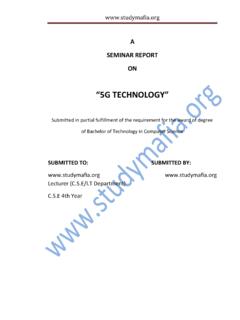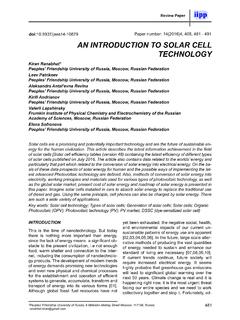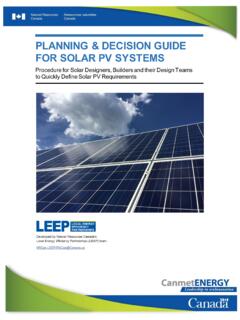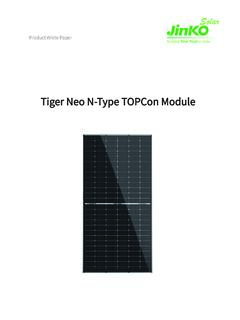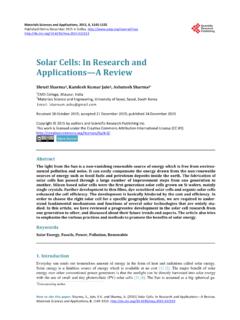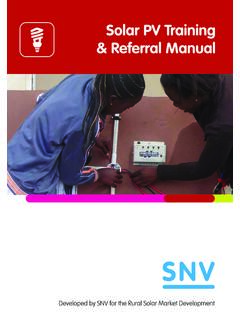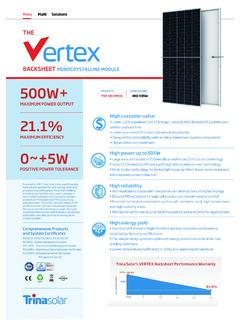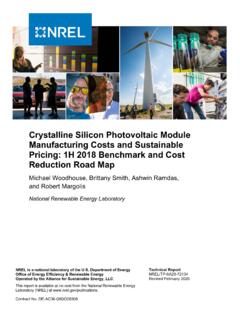Transcription of Solar Mobile Charger - Study Mafia
1 A. Seminar report On Solar Mobile Charger Submitted in partial fulfillment of the requirement for the award of degree Of ECE. SUBMITTED TO: SUBMITTED BY: Acknowledgement I would like to thank respected Mr .. and Mr..for giving me such a wonderful opportunity to expand my knowledge for my own branch and giving me guidelines to present a seminar report. It helped me a lot to realize of what we Study for. Secondly, I would like to thank my parents who patiently helped me as i went through my work and helped to modify and eliminate some of the irrelevant or un-necessary stuffs. Thirdly, I would like to thank my friends who helped me to make my work more organized and well-stacked till the end. Next, I would thank Microsoft for developing such a wonderful tool like MS Word. It helped my work a lot to remain error-free. Last but clearly not the least, I would thank The Almighty for giving me strength to complete my report on time. Preface I have made this report file on the topic Solar Mobile Charger ; I have tried my best to elucidate all the relevant detail to the topic to be included in the report.
2 While in the beginning I have tried to give a general view about this topic. My efforts and wholehearted co-corporation of each and everyone has ended on a successful note. I express my sincere gratitude to ..who assisting me throughout the preparation of this topic. I thank him for providing me the reinforcement, confidence and most importantly the track for the topic whenever I needed it. CONTENT. Introduction Photovoltaic cell Principle of PV cell Manufacturing of Solar cells Applications Solar Mobile Charger unit Specification of Charger Design of Charger Cell in series Final work Advantages Disadvantages Conclusion INTRODUCTION. Solar energy is the energy produced directly by the sun and collected elsewhere, normally the Earth. The sun creates its energy through a thermonuclear process . The process creates heat and electromagnetic radiation. Only a very small fraction of the total radiation produced reaches the Earth. The radiation that does reaches the Earth is the indirect source of nearly every type of energy used today.
3 The radiation that does reach the Earth is the indirect source of nearly every type of energy used today. The exceptions are geothermal energy, and nuclear fission and fusion. Even fossil fuels owe their origins to the sun; they were once living plants and animals whose life was dependent upon the sun. Much of the world's required energy can be supplied directly by Solar power. More still can be provided indirectly. The practicality of doing so will be examined, as well as the benefits and drawbacks. In addition, the uses Solar energy is currently applied to will be noted. Due to the nature of Solar energy, two components are required to have a functional Solar energy generator. These two components are a collector and a storage unit. The collector simply collects the radiation that falls on it and converts a fraction of it to other forms of energy (either electricity and heat or heat alone). The storage unit is required because of the non-constant nature of Solar energy; at certain times only a very small amount of radiation will be received.
4 At night or during heavy cloudcover, for example, the amount of energy produced by the collector will be quite small. The storage unit can hold the excess energy produced during the periods of maximum productivity, and release it when the productivity drops. In practice, a backup power supply is usually added, too, for the situations when the amount of energy required is greater than both what is being produced and what is stored in the container PHOTOVOLTAIC CELL. The term "photovoltaic" comes from the Greek (photo) means "light", and "voltaic", means electric ,from the name of the Italian physicist VOLTA "after whom a unit of electro- motive force, the volt is named. The sun is a star made up of hydrogen and helium gas and it radiates an enormous amount of energy every second . A photovoltaic cell is an electrical device that convert the energy of light directly into electricity by photovoltaic effect. Photovoltaics is the field of technology and research related to the practical application of photovoltaic cells in producing electricity from light, though it is often used specifically to refer to the generation of electricity from sunlight.
5 Cells can be described as photovoltaic even when the light source is not necessarily sunlight (lamplight, artificial light, etc.). In such cases the cell is sometimes used as a photodetector (for example infrared detectors,detecting light or other electromagnetic radiation near the visible range, or measuring light intensity. The operation of a photovoltaic (PV) cell requires 3 basic attributes: The absorption of light, generating either electron-hole pairs or excitons. The separation of charge carriers of opposite types. The separate extraction of those carriers to an external circuit. In contrast, a Solar thermal collector collects heat by absorbing sunlight, for the purpose of either direct heating or indirect electrical power generation. "Photoelectrolytic cell". (photoelectrochemical cell), on the other hand, refers either a type of photovoltaic cell (like that developed by Becquerel and modern dye-sensitized Solar cells or a device that splits water directly into hydrogen and oxygen using only Solar illumination.))
6 Photovoltaic power generation employs Solar panels composed of a number of Solar cells containing a photovoltaic material. Materials presently used for photovoltaics include monocrystalline silicon , polycrystalline silicon , amorphous silicon , cadmium telluride, andcopper indium gallium selenide/sulfide. Due to the increased demand for renewable energy sources, the manufacturing of Solar cells and photovoltaic arrays has advanced considerably in recent years. Solar photovoltaics is a sustainable energy source. By the end of 2011, a total of GW had been installed, sufficient to generate 85 by end of 2012, the 100. GW installed capacity milestone was achieved. Solar photovoltaics is now, after hydro and wind power, the third most important renewable energy source in terms of globally installed capacity. More than 100 countries use Solar PV. Installations may be ground-mounted (and sometimes integrated with farming and grazing) or built into the roof or walls of a building (either building-integrated photovoltaics or simply rooftop).
7 Driven by advances in technology and increases in manufacturing scale and sophistication, the cost of photovoltaics has declined steadily since the first Solar cells were manufactured, and the levelised cost of electricity (LCOE) from PV is competitive with conventional electricity sources in an expanding list of geographic regions. Net metering and financial incentives, such as preferential feed-in tariffs for Solar -generated electricity, have supported Solar PV installations in many current technology, photovoltaics recoup the energy needed to manufacture them in 3 to 4 years. Anticipated technology would reduce time needed to recoup the energy to 1 to 2 year. PRINCIPLE OF PV CELL. Solar cell works on the principle of photovoltaic effect. Sunlight is composed of photons, or "packets of energy. These photons contain various amounts of energy corresponding to the different wavelengths of light. When photons strike a Solar cell, they may be reflected or absorbed.
8 When a photon is absorbed, the energy of the photon is transferred to an electron in an atom of the cell (which is actually a semiconductor). With its new found energy, the electron is able to escape from itsnormal position associated with that atom to become part of the current in an electric MANUFACTURING OF Solar CELLS. Raw Materials: The basic component of a Solar cell is pure silicon , which is not pure in its natural state Purifying the silicon Making single crystal silicon Making silicon wafers making small small silicon crystal. Doping :Doping is used to increase the strength of the material. The anti-reflective coating :It is a type of opticlal coating applied to the surface of lenses. It improves efficiency. Encapsulating the cell APPLICATIONS. For low-power portable electronics, like calculators or small fans, a photovoltaic array may be a reasonable energy source rather than a battery. In other situations, such as Solar battery chargers, watches, and flashlights, the photovoltaic array is used to generate electricity.
9 Solar chargers can charge lead acid or Ni-Cd battery bank up to 48 V and hundreds of ampere-hours (up to 400 Ah) capacity. For such type of Solar chargers, generally intelligent charge controllers are used. A series of Solar cell array plates are installed separately on roof top and can be connected to battery bank. Such arrangement can also be used in addition to mains supply chargers for energy saving during day times. Most portable chargers can obtain energy from the sun only. Portable knob's are also sold. Some, including the Kinesis K3, can work either way. Examples of Solar chargers in popular use include: Small portable models designed to charge a range of different Mobile phones, cell phones, iPods or other portable audio equipment. Fold out models designed to sit on the dashboard of an automobile and plug into the cigar lighter, to keep the battery topped up whilst not in use. Torches, often combined with a secondary means of charging, such as a kinetic charging system.
10 Public Solar chargers permanently installed in public places, such as parks, squares and streets, which passersby can use for free. Solar Mobile Charger UNIT. Portable Solar Mobile Charger for Mobile phone can be charged with Sun light and electrical power. It stores power from the sun and charge Mobile phone,iPod,etc. Solar cell phone chargers use Solar panels to charge cell phone batteries. They are an alternative to conventional electrical cell phone chargers and in some cases can be plugged into an electrical outlet. There are also public Solar chargers for Mobile phones which can be installed permanently in public places such as streets, park and squares. The model which is according to European Commission proclaimed as the first in the world is the Strawberry Tree, public Solar Charger invented by Strawberry energy Company. This Solar station won the first place at "EU Sustainable energy week (EUSEW) 2011" in the Consuming category. Some models of cell phones have a built in Solar Charger and are commercially available for GSM cellphone models.
